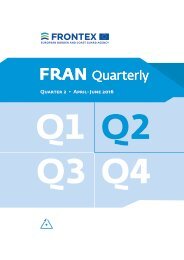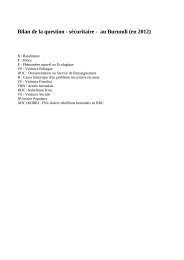Create successful ePaper yourself
Turn your PDF publications into a flip-book with our unique Google optimized e-Paper software.
DAVEED GARTENSTEIN-ROSS<br />
itself through attacks. 5 Thus, claims of a growing IS presence should be<br />
cross-checked against kinetic actions undertaken by militants.<br />
5. Local resistance to IS’s presence or rule. Anti-IS uprisings can be monitored<br />
on social media and are highly relevant to determining the group’s<br />
level of overall local support.<br />
6. Local sentiment. Both Internet and social media penetration are often<br />
quite low in areas where IS has a strong presence. For example, Internet<br />
penetration is about 42.7 percent in Nigeria, 31.7 percent in Egypt, 28.1<br />
percent in Syria, 17.8 percent in Libya, 11.3 percent in Iraq, and 1.6 percent<br />
in Somalia. 6 Low Internet and social media penetration can make it<br />
difficult to assess local sentiment, which is highly relevant but one of the<br />
more difficult categories to measure through social media.<br />
7. Local history. As previously noted, the shadows are the natural habitat<br />
of most VNSAs. The history of a locality can help analysts understand<br />
when other militant groups could block or impede IS’s inroads, even if<br />
these groups don’t naturally protest its presence at the outset.<br />
I now detail how social media analysis can shed light on support for IS in<br />
several theaters, and how IS has sometimes used social media to manipulate<br />
perceptions of its strength. I will examine the case studies of IS’s branches in<br />
Yemen and the Libyan city of Darnah before turning to concluding thoughts.<br />
YEMEN<br />
IS’s expansion into Yemen has come against a backdrop of civil conflict<br />
and growing chaos. In 2014, tensions intensified between President Abdu<br />
Rabu Mansour Hadi’s government and the Houthis, a movement based in<br />
northern Yemen that follows the Zaidi school of Shia Islam. In September<br />
2014, Houthi militants moved into the capital of Sana. In February 2015, the<br />
Houthis, backed by forces loyal to deposed president Ali Abdullah Saleh, dissolved<br />
the parliament and raided the presidential palace, placing Hadi under<br />
house arrest. (Hadi managed to flee to Saudi Arabia in March 2015.) As the<br />
Houthis, backed in part by Iran, pushed toward the last major pro-Hadi bastion<br />
in the coastal city of Aden, Saudi Arabia and Sunni government partners<br />
from the Gulf Cooperation Council launched a military offensive aimed<br />
at driving back the Houthis and restoring Hadi’s government.<br />
At the outset, the Yemen conflict appeared to play to IS’s strengths, as the<br />
group has experienced inflaming tensions with Shiites while portraying itself as<br />
52






